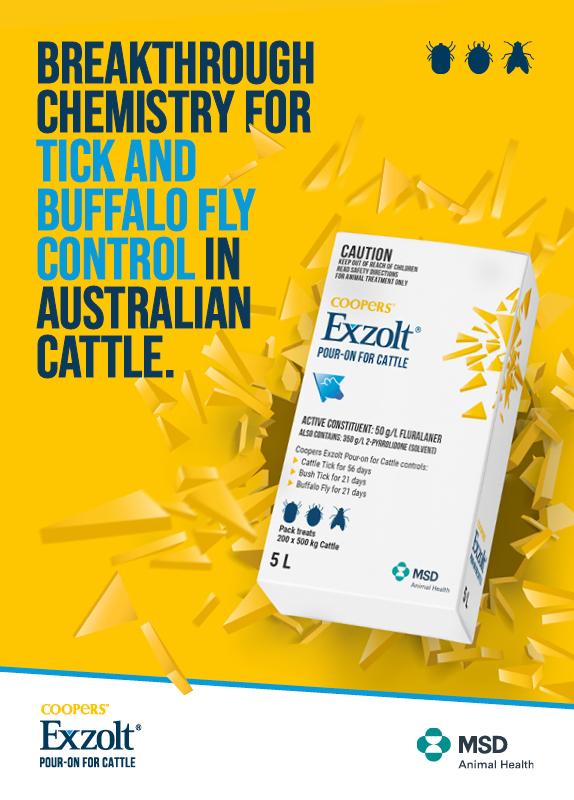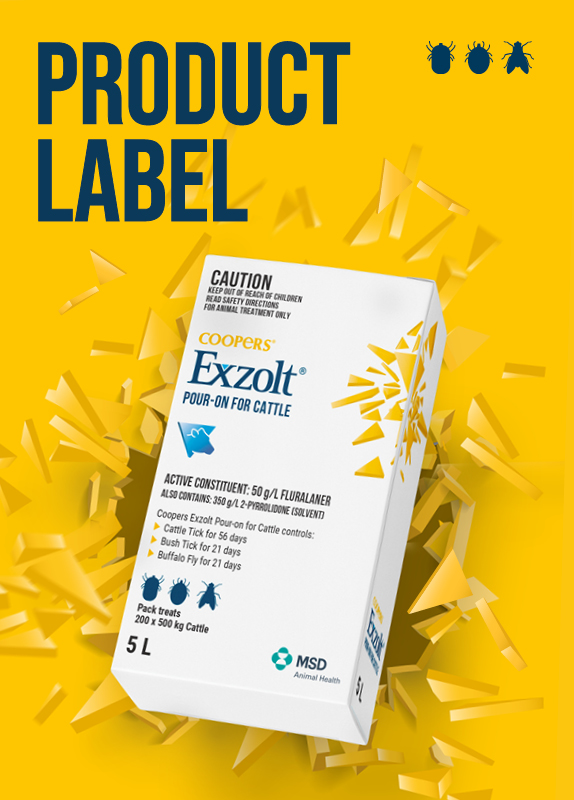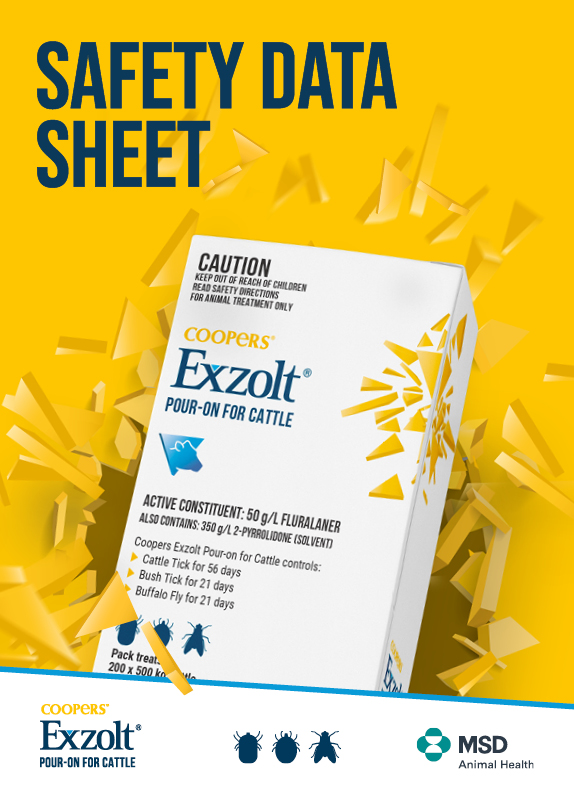

Frequently asked questions
Coopers® Exzolt® Pour-on for Cattle – Frequently Asked Questions
Withholding periods:
Meat: DO NOT USE less than 38 days before slaughter for human consumption.
Milk: DO NOT USE in cows which are producing or may in the future produce milk that may be used or processed for human consumption except replacement dairy heifers prior to first mating.
ESI: DO NOT USE less than 88 days before slaughter for export.
Retreatment interval: DO NOT re-treat animals for 88 days after last treatment.
What is the minimum period of time that treatment can be applied prior to a rainfall event occurring?
- The efficacy of Coopers Exzolt Pour-on for Cattle is not adversely affected by heavy rainfall after treatment.
- Study data demonstrated that artificial rain applied by inverted sprinklers (equivalent to rainfall of 22-23 mm in a storm lasting approximately 20 minutes) 6, 12, or 24 hours following treatment did not adversely affect efficacy.1
Do cattle need to be dry at time of treatment?
Yes, cattle must be dry when treatment occurs.
The re-treatment interval of Coopers Exzolt Pour-on for Cattle is 88 days, what happens if my cattle become re-infested with ticks &/or buffalo fly? Can I treat with another product?
Yes, the re-treatment period only relates to Coopers Exzolt Pour-on for Cattle. If cattle require another treatment once the period of protection has lapsed for the target parasite, then an active from another chemical group can be administered. In addition, if Coopers Exzolt Pour-on for Cattle is used twice in the season, ensure chemical groups are rotated and do not use the same active for two consecutive treatments.
Does Coopers Exzolt Pour-on for Cattle affect dung beetles?
Yes, it is toxic to dung beetles. Use of the product as directed is not expected to have long-term adverse effects on dung fauna or dung degradation.
Is Coopers Exzolt Pour-on for Cattle safe to use on breeding bulls?
Safety in breeding bulls has not been evaluated.
How quickly can I expect Coopers Exzolt Pour-on for Cattle to work against ticks and buffalo fly?
Effective control (>95% efficacy) of cattle ticks, bush ticks and buffalo fly can be expected within 1 to 5 days.
Will it control paralysis tick on young calves?
There is no label claim for the control of paralysis tick.
Note: safety in calves <6 months has not been determined & dosing commences at 200 kg.
Will it treat lice on cattle?
No trials have not been conducted to determine how effective Coopers Exzolt Pour-on for Cattle is against cattle lice.
Does is cause hair loss or skin sores?
Topical treatment with Coopers Exzolt Pour-on for Cattle is generally well tolerated and no serious adverse reactions have occurred in the studies. Mild and transient local skin reactions may occur, which do not affect the general health of the animals and do not require specific treatment. If a skin reaction does occur, it is cosmetic in nature and will typically resolve within 41 days after treatment.
The Coopers Exzolt Pour-on for Cattle applicator comes with two nozzles. Is it just personal preference on which one to use?
Yes – producers can use either – whichever they prefer.
The applicator comes standard with the rose nozzle, however to overcome dripping which has been reported by producers in other countries, a fan nozzle has also been provided. The rose nozzle drips a little after application and a mesh insert has been added to reduce this. There is less dripping observed when the fan nozzle is used.
Coopers Exzolt Pour-on for Cattle needs to be applied as a narrow strip along the midline of the back from the withers to the base of the tail. When using a fan nozzle, to avoid a wider band, do not depress the plunger quickly on the fan spray.
How important is the narrow strip administration given much of the efficacy relies on grooming?
In the studies that were conducted, Coopers Exzolt Pour-On for Cattle was administered topically in narrow strip (along the midline of the back from the withers to the base of the tail) which is why it is recommended.
Can it be used in horses?
No. There have been no studies or trial work done for the safety or efficacy in horses.
Additional questions?
If the answer to your question is not on this Frequently Asked Questions list or you require additional information, please contact MSD Animal Health customer service on 1800 226 511
- MSD data on file.
Coopers Exzolt Pour-on for Cattle must be used in accordance with the product label and any other instructions provided by MSD Animal Health.
Brochure, Label & SDS
For more information on Coopers Exzolt Pour-on for Cattle CLICK HERE or call 1800 226 511.
*In accordance with WAAVP Guidelines for evaluating the efficacy of acaricides against ticks (Ixodidae) on ruminants and WAAVP Guideline for evaluating the efficacy of parasiticides against ectoparasites of ruminants
1. MSD data on file, 2024
2. Department of Industry, Tourism and Trade Northern Territory, Acaricide (chemical) resistance in cattle
ticks. 2022.
3. Kotze, AC. and Hunt, PW., The current status and outlook for insecticide, acaricide and anthelmintic
resistances across the Australian ruminant livestock industries: assessing the threat these resistances
pose to the livestock sector. Aust Vet J. 2023; 101: 321–333.
https://doi.org/10.1111/avj.13267
4. Ball M, Watt B. Cattle tick management in SE Queensland. Flock and Herd Case Notes, Sydney, 2018
Available at: http://www.flockandherd.net.au/cattle/ireader/cattle-tick-management.html
APVMA No.: 92557/135894.
® Registered trademarks. Copyright © 2024 Merck & Co., Inc., Rahway, NJ, USA and its affiliates. All rights reserved.




